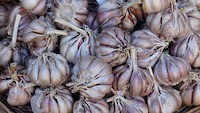Copyright © University of Cambridge. All rights reserved.
'Growing Garlic' printed from https://nrich.maths.org/
Show menu
Why do this problem?
The idea of this problem is to encourage children to identify and describe a pattern, and to extend this into a general rule. Depending on their experience, they can also be encouraged to use relevant vocabulary associated with factors and multiples.
Possible approach
This problem featured in the NRICH Primary webinar in April 2022.
You could use this problem with the whole class as it is an example of a low threshold high ceiling activity - accessible to all but also having in-built challenge for the most confident.
You may want to start by asking some simpler questions, for example:
Ben has 15 bulbs of garlic.
- Can he plant them in two equal rows? Why or why not?
- Can he plant them in three equal rows? Why or why not?
- Can he plant them in four equal rows? Why or why not?
- What else could you tell me?
In each case, encourage learners to use practical resources, to show their solution.
Then, ask the children to find how many bulbs Ben could have if he plants them in three equal rows but has one left over, as in the first part of the problem. Have cubes, counters, bottle tops, squared paper, hundred squares... available for everyone to use, should they wish. List children's suggestions and use the interactivity, or counters/magnets on the board, to check them. The interactivity offers a visual representation of factors, multiples and remainders by arranging numbered garlic cloves into a rectangular array, i.e. into rows of equal size). The 'left over' cloves are circled in red.
Rearrange the solutions in order of size on the board and ask learners what they notice. Encourage comments which indicate the children have identified the pattern ("It's one more than the three times table") rather than them offering specific examples that 'fit' (it could be 22, 4, 31...). Many will make comments about the "numbers going up in threes", which is absolutely correct and an excellent starting point. However, 'one more than the three times table', or 'one more than a multiple of three' allows us to identify instantly whether a particular number is in the sequence, as opposed to having to list all the numbers in order, going up in threes.
Pose the rest of the problem and leave the class to pursue their ideas, working in pairs. You may wish them to have access to the interactivity in pairs as well as access to a range of practical resources. Emphasise that you are interested in their answer or answers, but you are particularly interested in how they go about finding solutions. As they work, look out for pairs who have developed useful ways of recording their thinking. Some learners will be recording to help them find a solution (e.g. drawing blobs for the garlic bulbs), some will be recording to keep track of what they have tried - what has worked and what has not! Use a mini plenary to draw attention to some of the different ways of recording and encourage children to share their reasons for recording in this way.
Bring everyone together to share solutions and help them to differentiate between specific answers and general ones ("If there is one left over with two rows it must be an odd number", rather than "It must be 21 or 15 or 7"). It is interesting to note that there are far fewer multiples of 6 between 1 and 100 than multiples of 2, so starting with numbers that are one more than a multiple of 6 would give fewer possibilities compared with starting with odd numbers. Look out for learners that realise this, thus demonstrating their deep understanding of the number system.
Key questions
Possible support
Physical apparatus helps to consolidate the idea of 'one more than a multiple'. Listing possible answers in order of size can also help the children to spot patterns and encourages them to work systematically.
Possible extension
Children could create their own question with a unique answer for a partner to solve.
 Ben is on the allotment with his Mum. They would like to grow some garlic and are deciding how to plant the garlic cloves.
Ben is on the allotment with his Mum. They would like to grow some garlic and are deciding how to plant the garlic cloves.